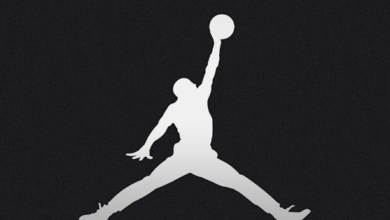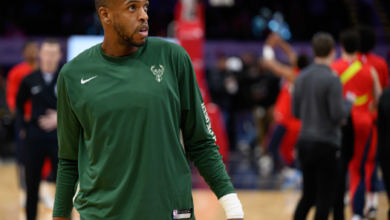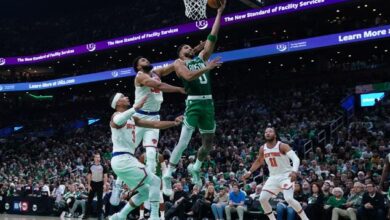How Union, Freiburg are turning the Bundesliga upside down

In retrospect, Danny Drinkwater‘s prowess was the sign that Leicester City had something special going on. The Foxes had plenty of soon-to-be huge names on their Premier League-winning 2015-16 roster — N’Golo Kante, Riyad Mahrez and of course Jamie Vardy — but after Drinkwater made a big-money move to Chelsea in 2017, he was barely heard from again. He had two goals and eight assists during Leicester’s magical title run and a total of two goals and one assist in parts of four other Premier League seasons.
While European soccer was well into the process of moving toward possession as the ultimate goal for all of the most dominant teams, nobody was pulling that off perfectly in England in 2015-16. Louis van Gaal’s Manchester United topped the Premier League’s possession list at just 58%, trailed slightly by Arsene Wenger’s Arsenal, Manuel Pellegrini’s Manchester City and Mauricio Pochettino’s Tottenham Hotspur. None of those teams made it past the quarterfinals of either the Champions League or Europa League.
Leicester, meanwhile, proved that in the absence of a team that could do everything required of it at a continental level, a team that does very specific things particularly well can win a lot of matches.
They had basically one way to score. In open-play sequences ending in goals, Vardy had 41 touches, Mahrez 36, Drinkwater 22 and Kante 17. Marc Albrighton and backup forward Leonardo Ulloa were the only others who had more than 10 touches. Leicester would recover the ball and funnel it to either Drinkwater or Kante (or both), who would quickly find either Vardy or Mahrez up the pitch. Vardy and Mahrez finished with 41 goals and 17 assists between them in league play; the entire rest of the team scored 26 goals. They defended well, counterattacked with vigor and, in just their second season after promotion from the English Championship, won the entire damn league.
It may be a while before an underdog pulls off something similar in the Premier League, but we’ve actually got two Leicester-esque stories brewing in the Bundesliga this season.
– Stream on ESPN+: LaLiga, Bundesliga, MLS, more (U.S.)
The power of doing a few things really, really well
Granted, SC Freiburg and Union Berlin haven’t exactly come out of nowhere like Leicester did. Freiburg have finished in the upper half of the Bundesliga four times since hiring manager Christian Streich (57) midway through 2011-12, while Union have only moved upward since naming Urs Fischer boss in 2018, earning promotion from the second division in his first season, then finishing 11th, seventh and fifth in the past three years. They are intensely well-run clubs, but they’re doing more than ever with less.
Transfermarkt values the Freiburg and Union rosters at a combined $294 million, far less than that of Bundesliga mates Bayern Munich ($967 million), RB Leipzig ($533 million), Borussia Dortmund ($531 million) or Bayer Leverkusen ($517 million). Those clubs all ended up in the Bundesliga top four last season and were the favorites to do so again in 2022-23, but only one is in the top four at present.
Each of those higher-value clubs has attempted to build modern, possession- and pressing-based rosters, but at the moment, they aren’t executing those systems particularly well. Leverkusen have forgotten how to finish, turning 1.7 expected goals (xG) per match (third most in the league) into just 1.3 goals (ninth) while going from maybe the best transition team in the league to one of the worst. They have pulled just two points from five matches decided by zero to one goals, and while there are hints that their form is improving, they dug themselves a hole and are in 15th, eight points outside of the top four.
Leipzig fired Domenico Tedesco just one month into the season following losses to Eintracht Frankfurt and Shakhtar Donetsk by a combined 8-1. They have given away leads, and opponents have created far too many high-quality chances (RBL are allowing 0.13 xG per shot, 17th in the league). Marco Rose, recycled after recent stints at Dortmund and Borussia Monchengladbach, took over and engineered a 3-0 win over BVB, then suffered losses by 2-0 to Real Madrid (forgivable) and 3-0 to Gladbach (less so).
Borussia Dortmund are currently in second place thanks to four 1-0 league wins, but … 1-0! Dortmund! The Schwarzgelben are averaging just 1.3 xG per match, 10th in the league, and have traded some of their possession bona fides for a more direct and crosses-heavy approach. It runs counter to the club’s typical traits but better suits emergency signing Anthony Modeste, who was acquired from FC Cologne late in August after Sebastien Haller was diagnosed with a malignant testicular tumour. The downside of the approach was highlighted in the 3-0 loss at Leipzig.
And then there’s Bayern, mired in fifth place and winless in four straight league matches for the first time since approximately 1963. (Okay, not quite that long.) Statistically, there’s nothing inherently wrong with the 10-time defending league champions — they are first in goals scored, fourth in goals allowed and first in both xG and xG allowed. They are attempting nearly three times more shots than opponents, and while their shot quality isn’t as high as normal (their 0.11 xG per shot ranks seventh), their main issue has been a massive finishing slump that is guaranteed not to last much longer. However, neither Bayern’s higher-ups nor their fans tolerate blemishes. Drama is percolating and could make things messy for both manager Julian Nagelsmann and the team if they drop a few more points.
Perhaps order will return soon, but into the leadership void has stepped teams that aren’t trying to dominate every aspect of the game but are executing their plans absurdly well. Union are in first place and Freiburg are three points back in third.
Stubborn defense and brilliant patterns of play: The Union way
Before the season began, I talked to the sporting director of one of the Bundesliga’s Champions League clubs, and I asked him about the success of Union and Freiburg and whether that makes the league as a whole more difficult to prepare for from week to week. He wasn’t dismissive, per se, but you could tell he wasn’t exactly interested in replicating their ways. “They have their own style,” he said, “but the focus is on defending.
“The easiest way in football is defending and playing transition.”
It is a fact of life in soccer that while you can score five goals in a league match and still technically have a chance at losing, you will always get at least a point if you don’t allow a goal. Nail a single counterattack, and you might get three points. That is an equation that underdogs throughout the world will always try to follow.
Union’s growth under Fischer, however, has shown that you can execute this plan with a certain amount of upside, too. Last season, Eisern Union finished fifth in the league, just one point from a Champions League bid, by combining all the rigor and discipline you would expect from a defense-first 3-5-2 (or is it 5-3-2?) formation with perfect counterattacking personnel. Taiwo Awoniyi (15 goals with one assist from 27 chances created) and Sheraldo Becker (four goals and six assists from 41 chances) were both ultrafast and capable of winning 1-v-1s, Niko Giesselmann and Genki Haraguchi (combined: five goals, 12 assists, 54 chances created) showed off top-level speed and ball progression despite their 30-something ages and midfielder Grischa Promel (eight goals) was brilliant at providing a second wave in counterattacks, showing up unmarked in the box just as defenses thought they had everyone accounted for.
Union scored 50 goals (ninth in the league), which proved more than enough when combined with only 44 goals allowed (third) and a style conducive to securing points from close games (1.7 points per game in matches decided by zero or one goals, second in the league).
With Awoniyi leaving for Nottingham Forest and Promel joining TSG Hoffenheim — the Bundesliga’s fourth-place team and one that should maybe be in this piece as well — it was fair to wonder if Union’s specific recipe might turn out to be a little bit off in 2022-23. Instead, the team has gotten even sharper. American Jordan Pefok, acquired from Young Boys, took Awoniyi’s spot up front and has scored three goals with two assists from 10 chances created. All three of his goals were assisted by Becker, and both of his assists were to Becker — very Vardy-and-Mahrez-esque.
Becker, now the chief goal-scoring option in Awoniyi’s absence, already has six goals (more than his total from last season) and the three assists to Pefok. Pefok doesn’t quite have Awoniyi’s overall strength, but he and Becker might both be faster, and in what I call transition possessions — possessions that start outside the attacking third and last 20 or fewer seconds — Union are averaging 1.0 goals per match (first in the league) and allowing just 0.14 (also first). Their +0.86 per-game goal differential is the fourth best in Europe’s Big Five leagues, behind only Barcelona, Real Madrid and France’s Montpellier.
Meanwhile, in Promel’s absence, two other newcomers — midfielders Janik Haberer (acquired from Freiburg) and Morten Thorsby (Sampdoria) — have pitched in two goals and an assist in 639 combined minutes. And another new addition, center-back Diogo Leite, a 23-year-old on loan from FC Porto, has helped to make the defense even sharper, too. Union are allowing just 0.07 xG per shot, far lower than last year’s 0.11 and very nearly the lowest in Europe’s Big Five. Only AS Roma, Tottenham, Napoli and kindred defensive spirit Athletic Club are lower, and among those only Athletic and Napoli allow fewer shots.
Defense and transition might be “the easiest way in football,” but Union are pulling it off as well as just about anyone ever has. Maybe too well, actually.
Difference between goals scored and xG created, Europe’s Big Five:
Union Berlin: +1.2 per match (2.1 goals, 0.9 xG)
Manchester City: +1.2 (3.3, 2.1)
Montpellier: +1.0 (2.4, 1.4)
Tottenham Hotspur: +0.8 (2.6, 1.8)
Udinese: +0.8 (2.6, 1.8)
Union are second in the league in goals scored despite ranking ninth in shots per possession and 17th in xG per shot. Only 2.4% of their shot attempts have been worth 0.3 xG or more, the lowest in the league. Despite this, opponents have saved only 45% of their shots on target this season.
None of this feels sustainable, does it? The fact that City and Spurs are also on the xG overachievers list above is comforting — no one’s making a huge fuss over Erling Haaland or Harry Kane overachieving their xG (or Spurs benefiting from a pair of own goals), right? — but relying on such a devastating two-man attack will require both Becker and Pefok to continue (a) finishing at superhuman levels and (b) staying healthy. Regarding (b), Pefok has already missed two matches with injury, and Becker has missed about nine matches per year in the past three seasons.
Regarding (a), however, Union are doing something particularly interesting. Becker and Pefok have combined for nine goals on shots worth just 3.55 xG, which is indeed likely unsustainable. But really, they’re overachieving from a couple of specific spots on the pitch.
Within two small ranges on the pitch, Pefok and Becker have combined for seven goals (almost all in transition) on eight shots worth 1.3 xG. Everywhere else: two goals from 23 shots worth 2.2 xG. They know how to find their marks in counterattacking situations.
Their recent 2-0 win over VfL Wolfsburg perfectly demonstrated both types of scoring patterns. First, Becker, charging down the left, set Pefok up in his spot of choice to make it 1-0. Then Union put away the win with a charge straight up the middle from Becker.
While “Limit opponents’ looks while overachieving your xG dramatically” doesn’t sound like a sustainable recipe, “Limit opponents’ looks while creating specific looks for yourself,” almost does. Union’s patterns of play have been indomitable thus far. It will obviously be difficult to make this last for an entire season, but if you’re getting “Leicester City vibes,” as Gab Marcotti wrote a few days ago, this is why.
Set pieces, discipline and Freiburg
If you’re into the countercultural aspect of an underdog title run, but you just can’t get past Union’s poor xG numbers, perhaps Freiburg are the team for you! The club has more of a history of Bundesliga success than Union; they came just three points short of a league title in 1995 and have finished in the top half of the table six times since (whereas this is just Union’s fourth season ever in the Bundesliga).
Plus, their underlying stats are more sound thus far, and they’re also performing better in the Europa League — they’ve beaten Qarabag and Olympiakos by a combined 5-1, while Union have underperformed, losing to both Union Saint-Gilloise and Braga by 1-0 margins — which might be a decent sign of sustainability.
Streich’s also been doing this for a while. The 57-year-old spent most of his playing career with either Freiburg or lower-division Freiburger FC, and he was a coach for Freiburg’s U19 squad for more than 15 years before taking over the senior team in 2011. He’s gotten an up-close-and-personal glimpse of everything that does and doesn’t work for a club of Freiburg’s stature, and he’s been fine-tuning the recipe beautifully.
Freiburg’s approach is pretty close to Union’s — they’re similar in defensive organization, but their attack is based on a few more possession principles and less verticality. They’re allowing just 0.08 xG per shot in defense (third), and only 2.1% of opponents’ shots have been worth 0.3 xG or more (first), but unlike Union they aren’t just looking for specific shots in attack. They rank second in the league in shots per possession (0.17) and ninth in xG per shot (0.11), and 8.6% of their shots are worth at least 0.3 xG (fifth).
They’re also good at set pieces. Ridiculously, unfathomably good. Since the start of 2021-22, Freiburg have scored 24 set-piece goals — tied with Bayern for the most in Europe’s Big Five leagues — and allowed just seven. They scored 19 last season, and they’re on pace for 24 this year. (Yes, it’s a bit early for “on pace for…” stats, but still.) They scored from a pair of corners in a 3-2 win over Bayer Leverkusen, and they torched FC Augsburg on a pair of gorgeous free kicks to open up the floodgates of a 4-0 win on the season’s opening matchday.
They generate twice as many shots from set pieces as their opponents (3.3 shots per match vs. 1.6), and they create chances from a ridiculous number of them (52% of set-piece shots on target vs. opponents’ 9%).
Freiburg’s entire approach is personified by their most important player. Left midfielder/winger Vincenzo Grifo has long been one of the Bundesliga’s better creators whether playing for Freiburg, Hoffenheim or Gladbach, but while he’s averaged 0.06 goals per 90 with the others, he’s averaged 0.37 in his time with Freiburg. He is their set-pieces lynchpin, with four goals and 42 chances created on set pieces since the start of 2021-22.
Acquired for a transfer fee of just $7.7m three years ago, Grifo is a Drinkwater-esque figure — he would be valuable anywhere, but he means the world to Streich’s squad. The same could be said for a trio of newcomers.
Veteran center-forward Michael Gregoritsch was signed from Augsburg on a free transfer this summer and, with three goals, is already nearly halfway to last year’s total of eight. Winger Ritsu Doan, 24, was pulled from PSV Eindhoven for a $9.4m transfer fee, and after scoring nine goals in all competitions last year he is already at four for Freiburg. (He’s also a pressures machine up front.) Then there’s center-back Matthias Ginter, who moved over from Borussia Monchengladbach to replace the Dortmund-bound Nico Schlotterbeck and has already scored twice on set pieces while playing the sturdy defense that has earned him 46 caps for Germany.
This won’t last … right?
Both Freiburg and Union are indeed underdog stories, made up of semi-cheap players bigger clubs could have acquired but chose not to. But the talent is real, as is the athleticism, from Becker’s and Pefok’s speed to Ginter’s and Gregoritsch’s physicality. Because they play what you might call less modernized styles, they are in less danger of seeing their best players plucked away by Bayern and others — in the past three years, only Awoniyi and Schlotterbeck have left either team for particularly big transfer fees — which lends them both an opportunity to remain good for a long period of time.
It probably goes without saying, however, that their odds of pulling a Leicester this season will depend significantly on whether other clubs get their respective acts together.
The math isn’t yet in their favor. FiveThirtyEight’s SPI ratings give Union and Freiburg each just a 3% chance of winning the league, and Caesars gives them betting odds of +5000 and +6500, equivalent to a 2% and 1.5% chance, respectively. But it is perhaps noteworthy that both SPI and Caesars give them the third- and fourth-best odds of finishing in the top four and therefore qualifying for next year’s Champions League. The headway they’ve made early this season — and the ground bigger clubs have given up — has had a lasting effect in that regard.
Will the “Leicester vibes” last? Odds aren’t strong. But if the odds were good, there wouldn’t have been Leicester vibes in the first place!
Source link





